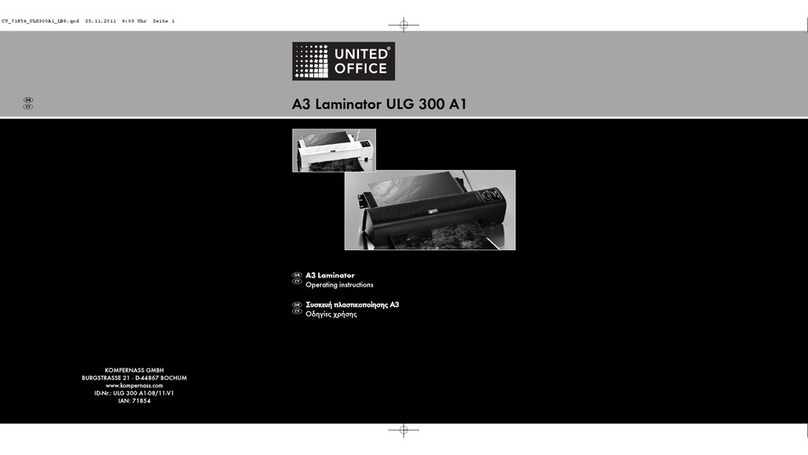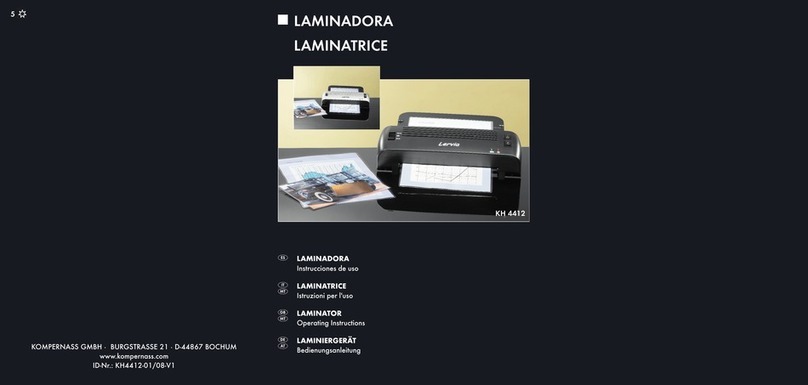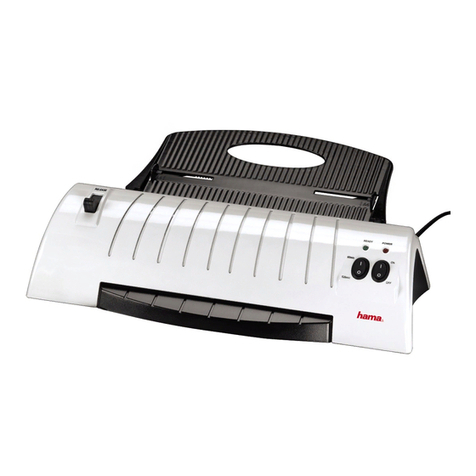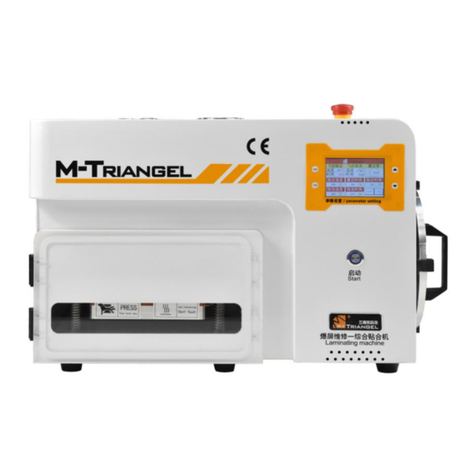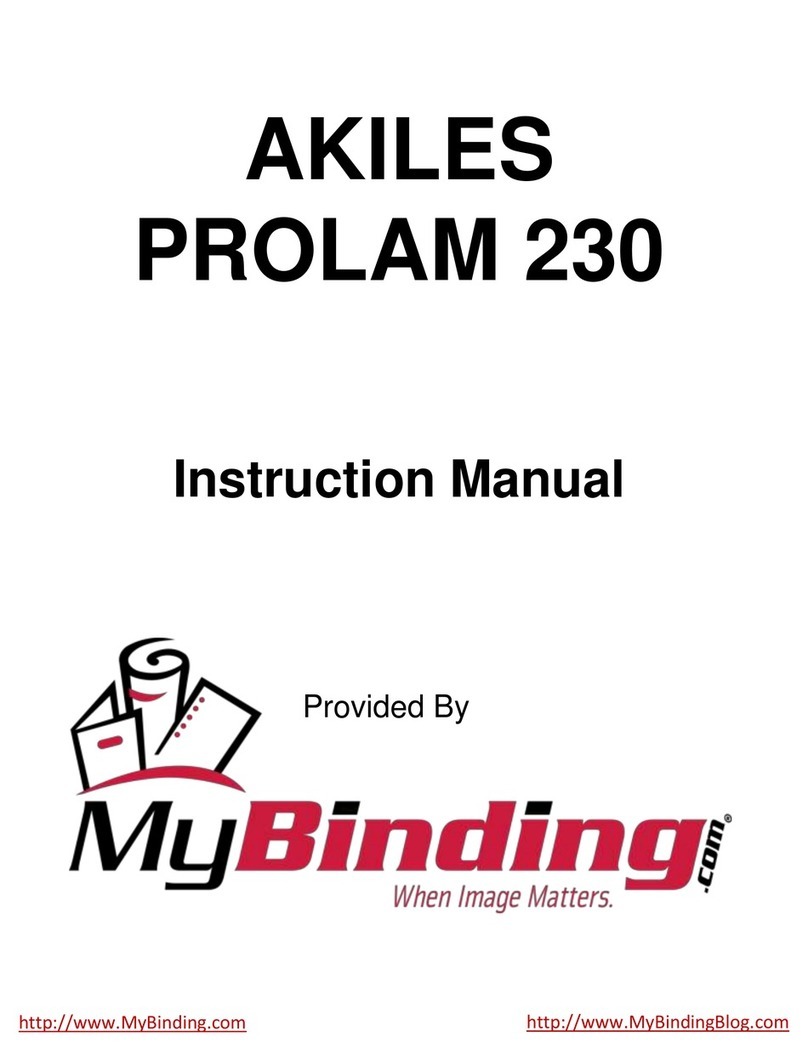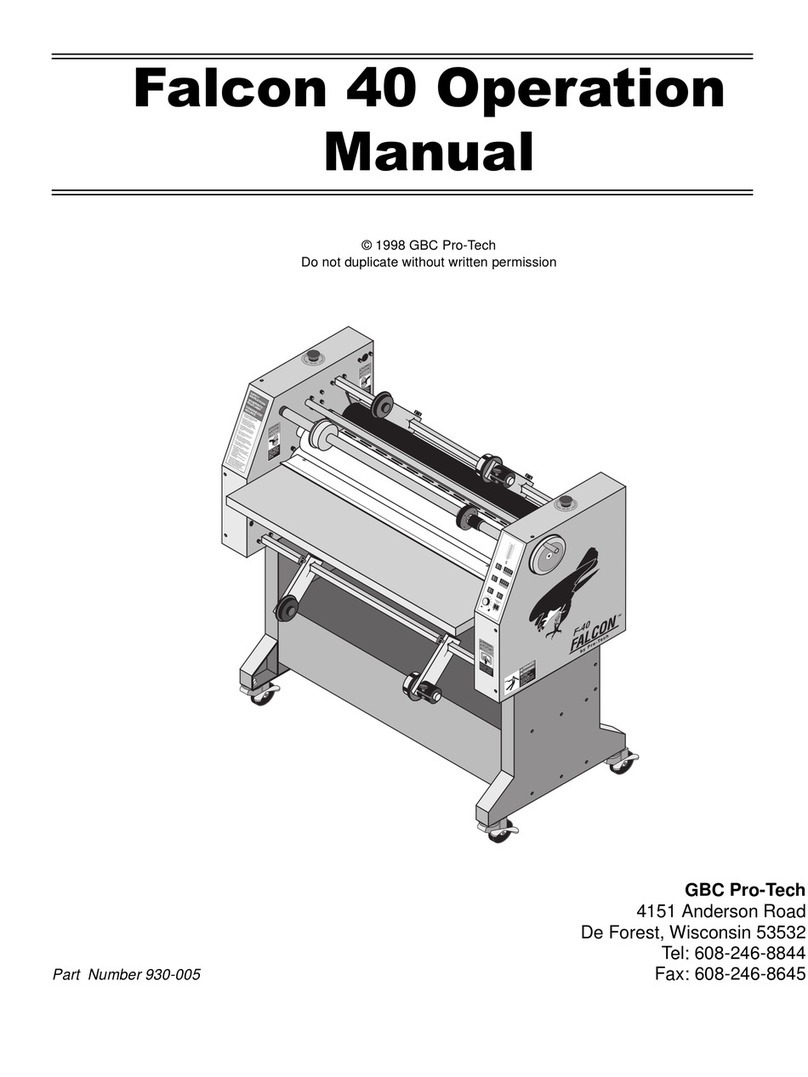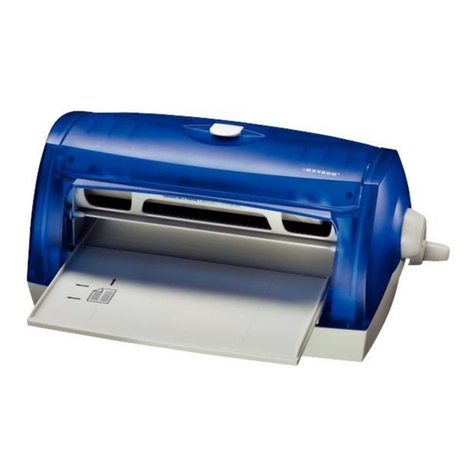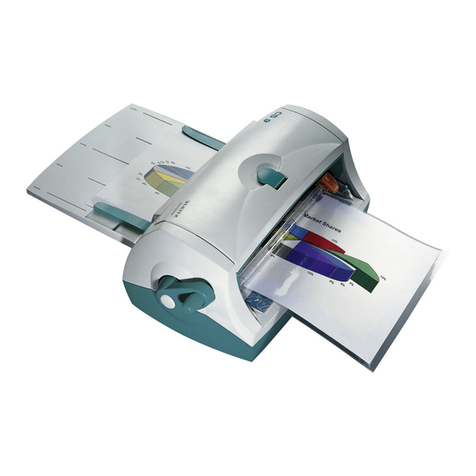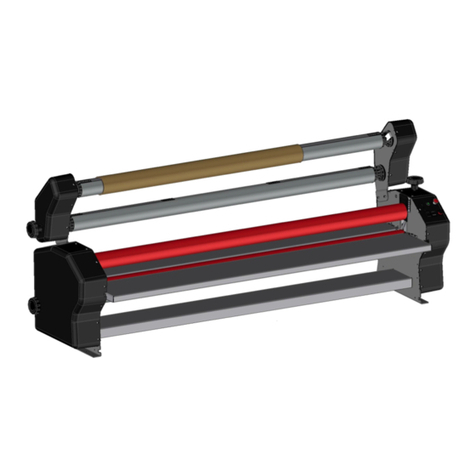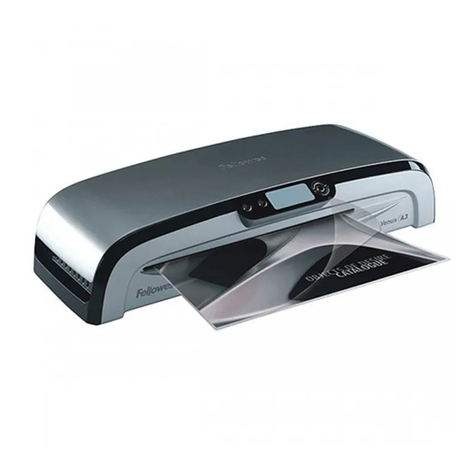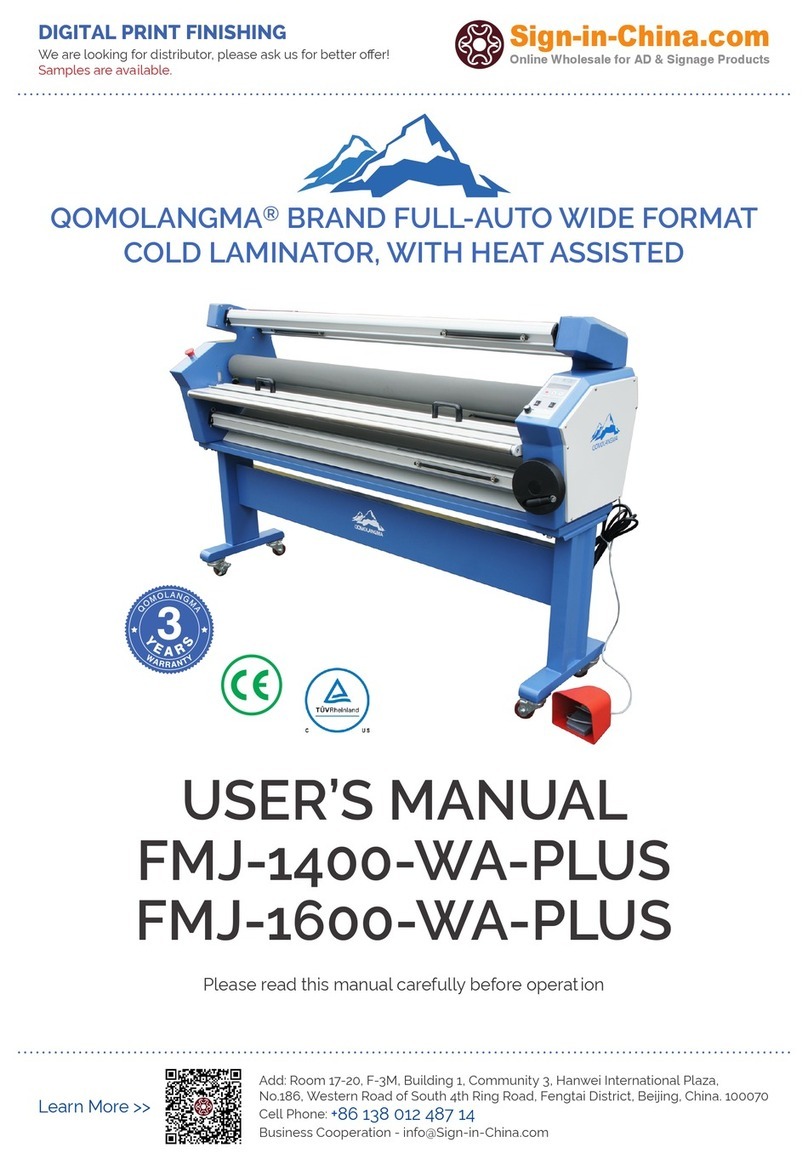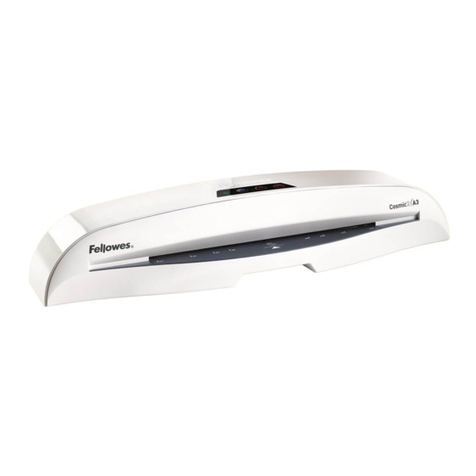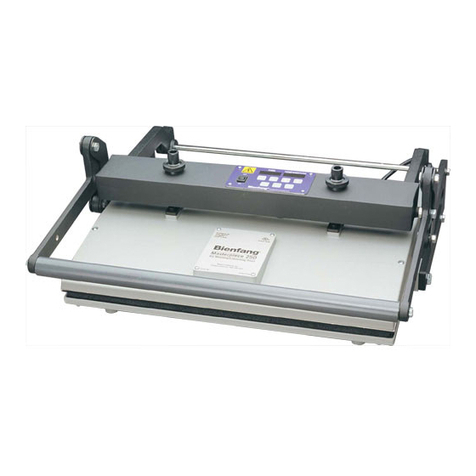Kompernass LERVIA KH 230 User manual

KH 230
Operating instructions

2
Operating instructions
Your new Lervia laminating device can be used for hot and cold laminating of plastic lm for
protection of pictures, cards, documents, etc.
The laminating device is suitable for lm pouch sizes of up to format DIN A4.
Technical data
• Power supply AC 230 V ~ 50 Hz
• Power 200 W
• Dimensions L x W x H 336 x 146 x 75 mm
• Net weight 1,56 kg
• Max. laminating width 230 mm
• Max. laminating thickness 1,0 mm
• Laminating speed 0,3 m/Minute
• Roller temperature 120° C
Safety information
Setting up the laminating device:
• The machine should not be set up in a damp area or in the vicinity of an air conditioning
outlet in order to prevent the occurrence of surface leakages.
• Ensure that the laminating device is set up upon a level, rigid and non-slip surface. There
must be sufcient space behind the device to allow laminated lms to exit. Therefore it is
important to ensure sufcient space between the rear-side of the device and any walls,
objects, etc..
• Never cover the laminating device and do not store any objects on it.
• The laminating device may only be connected to (230 V ~ 50 Hz) power sources. Multi-plug
systems may not be used.
• Please do not use extension cables.
Caution: The surface of the laminating device can get very hot during operation. Therefore the
surface of the device should not be touched when in operation – danger of burning!
Prior to laminating
1. Film pouches
1.1. Ensure that there is sufcient room between the edges of the lm pouch and the edges
of the material being laminated (3-5 mm). Always select a suitable lm pouch size for the
material being laminated.
1.2. We recommend using only standard quality lm pouches (as supplied with the
device), due to the very real danger of creasing when using sub-standard lm quality.
1.3. Please note that a lm pouch can only be used once.
1.4. The maximum lm pouch width is 230 mm.
2. Non-suitable laminating material
The following materials should not be laminated in order to prevent lm creasing and to reduce
the danger of accidents and damage to a minimum:
2.1. Inammable or materials that can melt (e.g. photographs etc.; these must be cold-lami-
nated)

3
2.2. Valuable, unique objects
2.3. Materials thicker than 1,0 mm
2.4. Drawings on heat-sensitive paper and/or material, whose colour and/or quality can be
effected by heat
Operating the laminating device
1. Cold laminating
Plug the laminating device’s plug into the power
supply socket. Switch on the device using the
power supply switch (1). The green light designating
“POWER” shines, showing that the device is switched
on. Set the selector switch (2) on the front-side of
the device to COLD. The yellow light designating
“COLD” shines. Place the material to be laminated in
a suitably sized lm pouch and feed it into the lami-
nating device. The laminating can now take place
automatically.
2. Hot laminating
Plug the laminating device’s plug into the power supply socket. Switch on the device using the
power supply switch (1). The green light designating “POWER” shines, showing that the device is
switched on. Set the selector switch (2) on the upper cover to HOT. The motor starts to run and
the device warms up to its operating temperature. The red light shines after a warm-up phase of
4–8 minutes; the rollers have now reached their operating temperature. Place the material to be
laminated in a suitably sized lm pouch. Then feed the lm pouch into the laminating device’s
infeed opening. The laminating can now take place automatically. Ensure that the material being
laminated lies directly on the fold of the lm pouch prior to the laminating. The lm pouch must
be fed into the laminating device with the fold in front.
In order to prevent creasing do not feed the lm pouch in with the open side facing into the
laminating device. Thus the pocket should not be cut-off prior to being used. Pay attention to
the pictograph on the infeed opening in order to ensure that the lm pouch is fed into the device
correctly.
3. Additional processing of the laminated lm pouch
When the lm pouch comes out of the machine after the laminating process it is very hot and can
easily lose its shape. Take great care when removing the lm pouch to prevent injury to oneself
or damage to the lm pouch. Place a book or other heavy object upon the lm pouch prior to it
cooling down. This will ensure a smooth and perfect surface.
4. Laminating device maintenance
The rollers should always be cleaned after use because the laminating performance sinks propor-
tionally with the amount of residue left on the rollers. Feed in a folded A4 sized piece of paper in
the laminating device opening. Carry out the normal laminating cycle as already described. The
residue on the rollers will now transfer and stay on the paper. Repeat this process a few times
until the rollers are completely clean. Caution: do not use fax paper when cleaning the rollers.
It is too smooth and too thin and can thus roll off the rollers too easily.
Clean the device’s housing and covers with a soft cloth and a mild soap. Caution: Switch off the
device and pull the plug out of the power supply prior to cleaning. The device must be completely
dry prior to being used for laminating again!
If the paper gets jammed and blocks the movement of the rollers because the paper can not be
pulled out of the device, switch the machine off immediately and pull out the plug. Then contact
your local laminating device representative or the local service partner.

4
Declaration of conformance
We, Kompernaß Handelsgesellschaft mbH, Burgstr. 21, D-44867 Bochum, Germany, declare this
appliance to be in conformance with all applicable international standards, safety requirements
and the EC Directives.
No. of appliance/Type: KH 230
Bochum, 30-11-2002
Hans Kompernaß
- Manager -

5

Table of contents
Other Kompernass Laminator manuals
